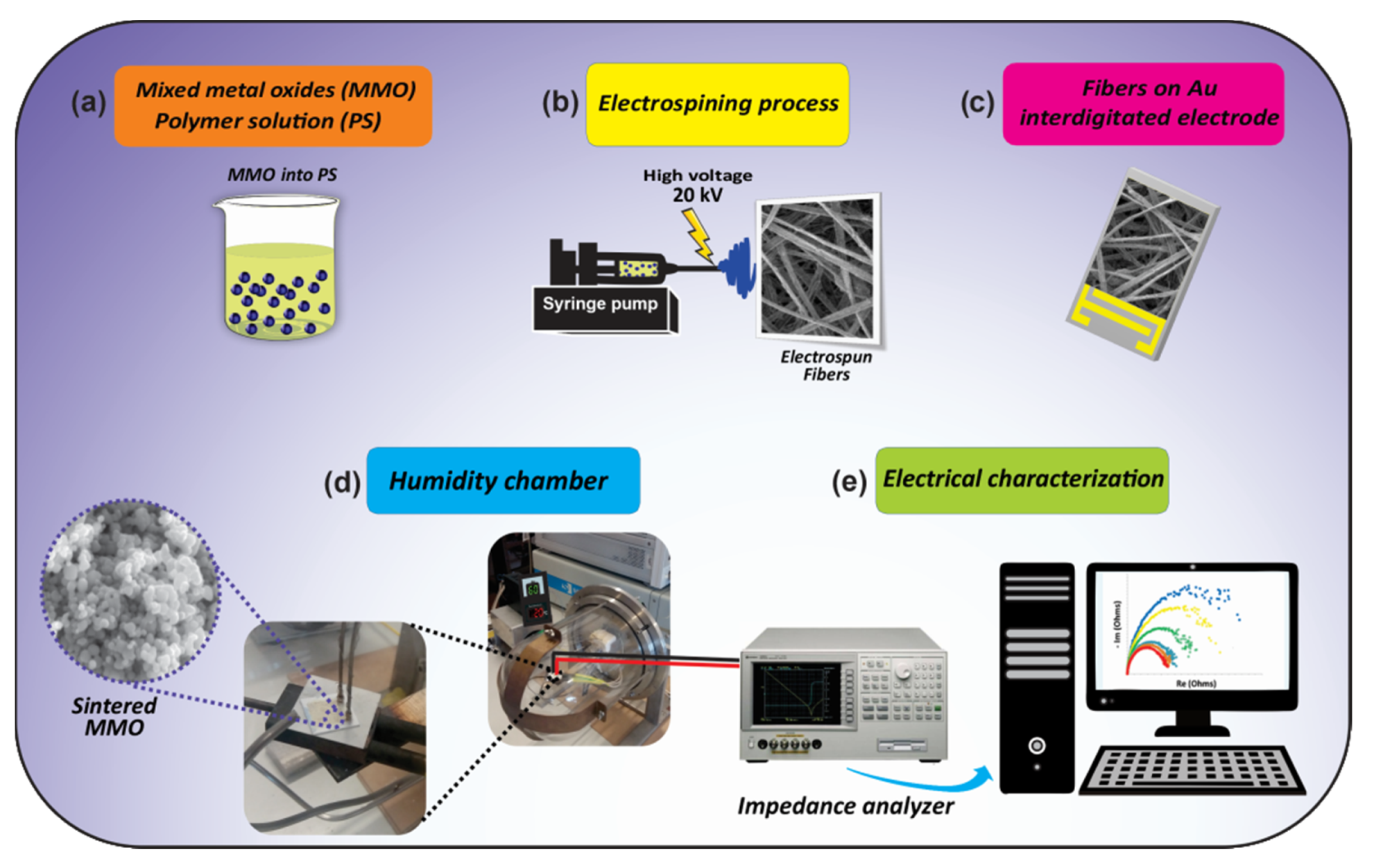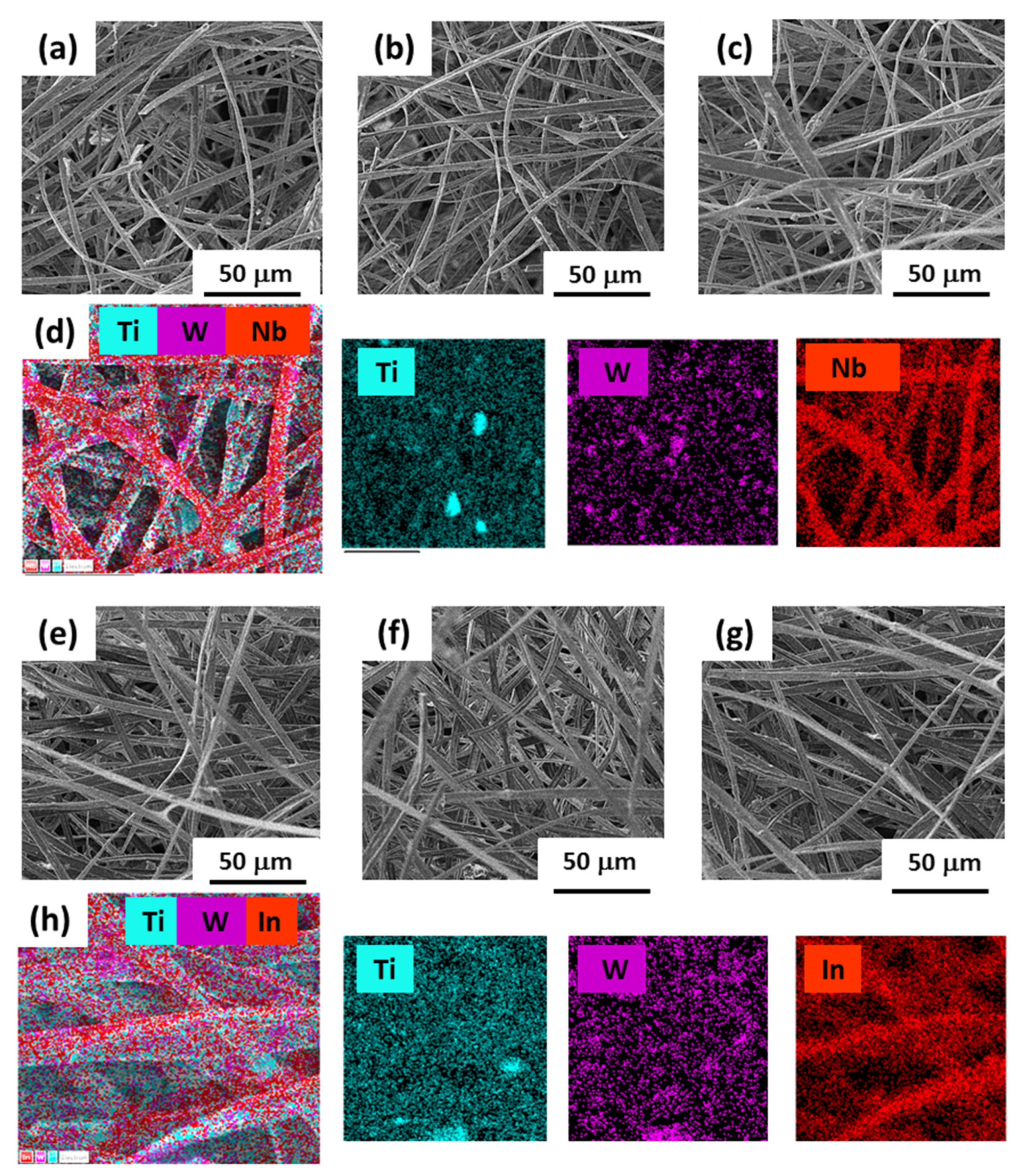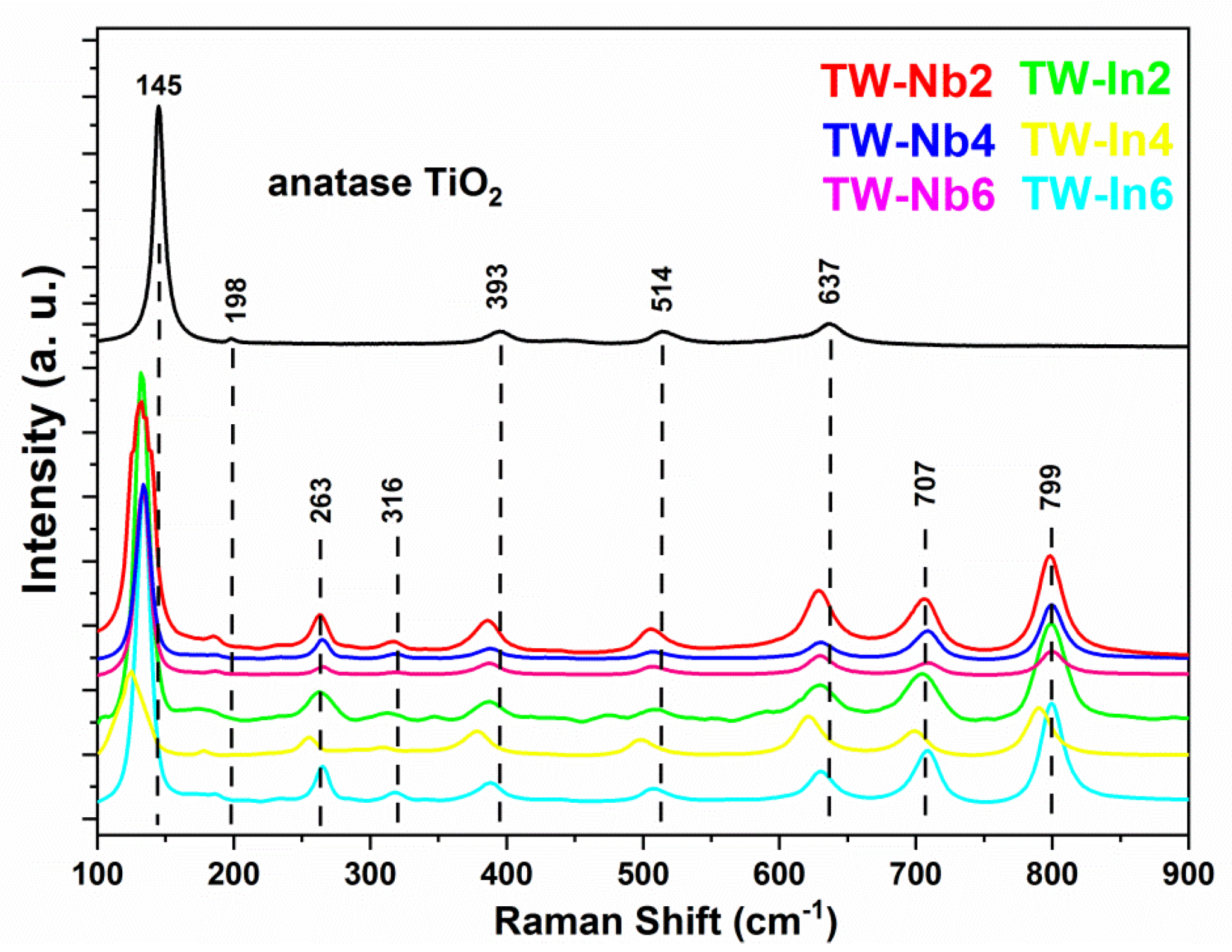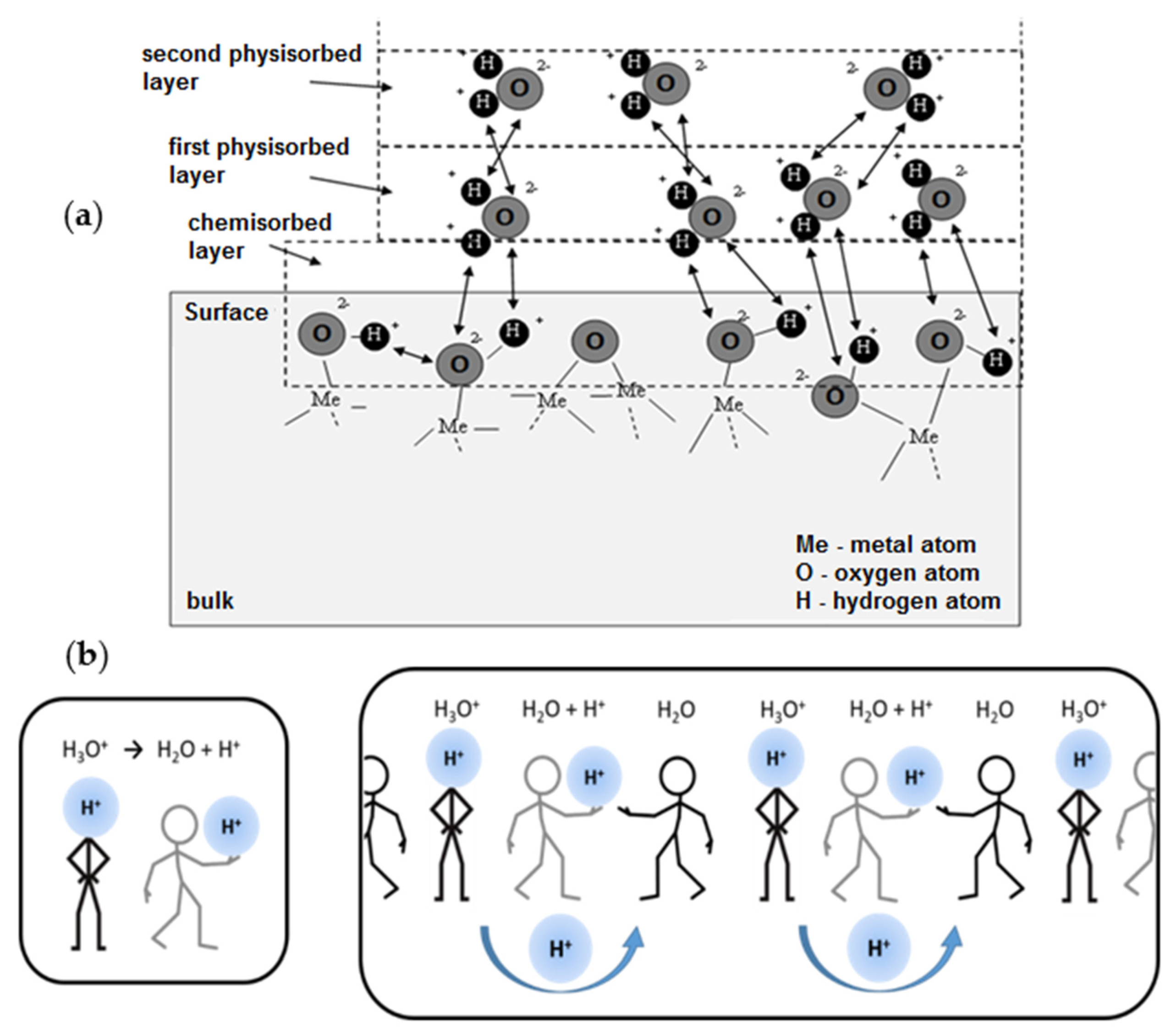Effect of
Abstract
1. Introduction
2. Materials and Methods
2.1. Materials
2.2. Sample Preparation
2.3. Microstructural Characterization
2.4. Electrical Response
2.5. Statistical Analysis
3. Results and Discussion
3.1. Microstructural Analysis
3.2. Electrical Response
4. Conclusions
Author Contributions
Funding
Institutional Review Board Statement
Informed Consent Statement
Conflicts of Interest
References
- Chavali, M.S.; Nikolova, M.P. Metal oxide nanoparticles and their applications in nanotechnology. SN Appl. Sci. 2019, 1, 607. [Google Scholar] [CrossRef]
- Steele, J.J.; Taschuk, M.T.; Brett, M.J. Nanostructured metal oxide thin films for humidity sensors. IEEE Sens. J. 2008, 8, 1422–1429. [Google Scholar] [CrossRef]
- Chowdhury, N.K.; Bhowmik, B. Micro/nanostructured gas sensors: The physics behind the nanostructure growth, sensing and selectivity mechanisms. Nanoscale Adv. 2021, 3, 73–93. [Google Scholar] [CrossRef]
- Shaheen, K.; Shah, Z.; Khan, B.; Adnan; Omer, M.; Alamzeb, M.; Suo, H. Electrical, photocatalytic, and humidity sensing applications of mixed metal oxide nanocomposites. ACS Omega 2020, 5, 7271–7279. [Google Scholar] [CrossRef]
- Jung, D.; Kim, J.; Lee, G.S. Enhanced humidity-sensing response of metal oxide coated carbon nanotube. Sens. Actuator. A Phys. 2015, 223, 11–17. [Google Scholar] [CrossRef]
- Ansari, M.O.; Ansari, S.A.; Cho, M.H.; Ansari, S.P.; Abdel-wahab, M.S.; Alshahrie, A. Conducting polymer nanocomposites as gas Sensors. In Functional Polymers; Jafar, M.M., Sheardown, H., Al-Ahmed, A., Eds.; Springer: New York, NY, USA, 2019; pp. 1–9. [Google Scholar] [CrossRef]
- Saqib, M.; Khan, S.A.; Mutee Ur Rehman, H.M.; Yang, Y.; Kim, S.; Rehman, M.M.; Young Kim, W. High-performance humidity sensor based on the graphene flower/zinc oxide composite. Nanomaterials 2021, 11, 242. [Google Scholar] [CrossRef] [PubMed]
- Tripathy, A.; Pramanik, S.; Cho, J.; Santhosh, J.; Abu Osman, N.A. Role of morphological structure, doping, and coating of different materials in the sensing characteristics of humidity sensors. Sensors 2014, 14, 16343–16422. [Google Scholar] [CrossRef]
- Faia, P.M.; Jesus, E.L.; Louro, C.S. TiO2:WO3 composite humidity sensors doped with ZnO and CuO investigated by impedance spectroscopy. Sens. Actuators B Chem. 2014, 203, 340–348. [Google Scholar] [CrossRef]
- Faia, P.M.; Libardi, J.; Louro, C.S. Effect of V2O5 doping on P- to N-conduction type transition of TiO2:WO3 composite humidity sensors. Sens. Actuators B Chem. 2016, 222, 952–964. [Google Scholar] [CrossRef]
- Faia, P.M.; Libardi, J.; Barbosa, I.; Araújo, E.S.; Oliveira, H.P. Preparation, characterization, and evaluation of humidity-dependent electrical properties of undoped and niobium oxide-doped TiO2:WO3 mixed powders. Adv. Mater. Sci. Eng. 2017, 2017, 2808262. [Google Scholar] [CrossRef]
- Baghali, M.; Jayathilaka, W.; Ramakrishna, S. The role of electrospun nanomaterials in the future of energy and environment. Materials 2021, 14, 558. [Google Scholar] [CrossRef]
- Araújo, E.S.; Leão, V.N.S. TiO2/WO3 heterogeneous structures prepared by electrospinning and sintering steps: Characterization and analysis of the impedance variation to humidity. Adv. Ceram. 2019, 8, 238–246. [Google Scholar] [CrossRef]
- Wang, Y.; Yokota, T.; Someya, T. Electrospun nanofiber-based soft electronics. NPG Asia Mater. 2021, 13, 22. [Google Scholar] [CrossRef]
- Korycka, P.; Mirek, A.; Kramek-Romanowska, K.; Grzeczkowicz, M.; Lewińska, D. Effect of electrospinning process variables on the size of polymer fibers and bead-on-string structures established with a 23 factorial design. Beilstein J. Nanotechnol. 2018, 9, 2466–2478. [Google Scholar] [CrossRef] [PubMed]
- Usha, K.S.; Sivakumar, R.; Sanjeeviraja, C. Optical constants and dispersion energy parameters of NiO thin films prepared by radio frequency magnetron sputtering technique. J. Appl. Phys. 2013, 114, 123501. [Google Scholar] [CrossRef]
- Blank, T.A.; Eksperiandova, L.P.; Belikov, K.N. Recent trends of ceramic humidity sensors development: A review. Sens. Actuators B Chem. 2016, 228, 416–442. [Google Scholar] [CrossRef]
- Gulshan, M.; Sai, M.L.S.; Hemalatha, T.; Sri, U.J.; Ramarao, N. Formulation and development of microspheres for the treatment of familial adenomatous polyposis. Int. J. Appl. Pharm. 2017, 9, 66–72. [Google Scholar] [CrossRef][Green Version]
- Farahani, H.; Wagiran, R.; Hamidon, M.N. Humidity sensors principle, mechanism, and fabrication technologies: A comprehensive review. Sensors 2014, 14, 7881–7939. [Google Scholar] [CrossRef]
- Shannon, R.D. Revised effective ionic radii and systematic studies of interatomic distances in halides and chalcogenides. Acta Crystallogr. A 1976, 32, 751–767. [Google Scholar] [CrossRef]
- Wiglusz, R.J.; Watras, A.; Malecka, M.; Deren, P.J.; Pazik, R. Structure evolution and up-conversion studies of ZnX2O4:Er3+/Yb3+(X = Al3+, Ga3+, In3+) nanoparticles. Eur. J. Inorg. Chem. 2014, 6, 109–1101. [Google Scholar] [CrossRef]
- Wojcieszak, D.; Mazur, M.; Kaczmarek, D.; Domaradzki, J. Influence of doping with Co, Cu, Ce and Fe on structure and photocatalytic activity of TiO2 nanoparticles. Mater. Sci. Poland 2017, 35, 725–732. [Google Scholar] [CrossRef]
- Sahoo, S.; Arora, A.K.; Sridharan, V. Raman line shapes of optical phonons of different symmetries in anatase TiO2 nanocrystals. J. Phys. Chem. C 2009, 113, 16927–16933. [Google Scholar] [CrossRef]
- Su, C.Y.; Lin, H.C.; Lin, C.K. Fabrication and optical properties of Ti-doped W18O49 nanorods using a modified plasma-arc gas-condensation technique. J. Vac. Sci. Technol. B 2009, 27, 2170–2174. [Google Scholar] [CrossRef]
- Yang, C.C.; Li, S. Size-dependent Raman red shifts of semiconductor nanocrystals. J. Phys. Chem. B 2008, 112, 14193–14197. [Google Scholar] [CrossRef] [PubMed]
- Cappelli, I.; Fort, A.; Lo Grasso, A.; Panzardi, E.; Mugnaini, M.; Vignoli, V. RH sensing by means of TiO2 nanoparticles: A comparison among different sensing techniques based on modeling and chemical/physical interpretation. Chemosensors 2020, 8, 89. [Google Scholar] [CrossRef]
- Raji, P.; Binitha, H.S.; Kumar, K.B. Synthesis and humidity sensing properties of Sn-doped nano-TiO2. J. Nanotechnol. 2011, 2011, 569036. [Google Scholar] [CrossRef]
- Şaşmaz Kuru, T. Synthesis and investigation of structural, dielectric, impedance, conductivity and humidity sensing properties of Cr3+-substituted Mg–Zn ferrite nanoparticle. Appl. Phys. A 2020, 126, 419. [Google Scholar] [CrossRef]
- Gurlo, A.; Bârsan, N.; Oprea, A.; Sahm, M.; Sahm, T.; Weimar, U. An n- to p-type conductivity transition induced by oxygen adsorption on α-Fe2O3. Appl. Phys. Lett. 2004, 85, 2280. [Google Scholar] [CrossRef]
- Sumets, M.; Dannangoda, G.C.; Kostyuchenko, A.; Ievlev, V.; Dybov, V.; Martirosyan, K.S. Temperature transition of p- to n-type conduction in the LiNbO3/Nb2O5 polycrystalline films. Mater. Chem. Phys. 2017, 191, 35–44. [Google Scholar] [CrossRef]
- Guo, L.; Wang, X.Q.; Zheng, X.T.; Yang, X.L.; Xu, F.J.; Tang, N.; Lu, L.W.; Ge, W.K.; Shen, B.; Dmowski, L.H.; et al. Revealing of the transition from n- to p-type conduction of InN:Mg by photoconductivity effect measurement. Sci. Rep. 2014, 4, 4371. [Google Scholar] [CrossRef]
- Bohra, A.K.; Bhatt, R.; Singh, A.; Bhattacharya, S.; Basu, R.; Meshram, K.N.; Sarkar, S.K.; Bhatt, P.; Patro, P.K.; Aswal, D.K.; et al. Transition from n- to p-type conduction concomitant with enhancement of figure-of-merit in Pb doped bismuth telluride: Material to device development. Mater. Des. 2018, 159, 127–137. [Google Scholar] [CrossRef]
- Pan, M.; Sheng, J.; Liu, J.; Shi, Z.; Jiu, L. Design and verification of humidity sensors based on magnesium oxide micro-arc oxidation film layers. Sensors 2020, 20, 1736. [Google Scholar] [CrossRef] [PubMed]
- Barsan, N.; Grigorovici, R.; Ionescu, R.; Motronea, M.; Vancu, A. Mechanism of gas detection in polycrystalline thick film SnO2 sensors. Thin Solid Films 1989, 171, 53–63. [Google Scholar] [CrossRef]








| Lattice Parameters | ||
|---|---|---|
| MMO | ||
| 3.781 | 9.527 | |
| 3.739 | 9.638 | |
| 3.720 | 9.722 | |
| 3.782 | 9.525 | |
| 3.751 | 9.585 | |
| 3.752 | 9.580 | |
| 2 | 4 | 6 | 2 | 4 | 6 | |
| RH (%) | Electrical response stability | |||||
| 50 | 96.1 | 97.2 | 98.1 | 96.7 | 95.7 | 96.7 |
| 70 | 95.9 | 96.9 | 97.1 | 96.9 | 98.3 | 97.6 |
| 90 | 97.7 | 97.3 | 97.3 | 96.1 | 97.6 | 96.8 |
Publisher’s Note: MDPI stays neutral with regard to jurisdictional claims in published maps and institutional affiliations. |
© 2021 by the authors. Licensee MDPI, Basel, Switzerland. This article is an open access article distributed under the terms and conditions of the Creative Commons Attribution (CC BY) license (https://creativecommons.org/licenses/by/4.0/).
Share and Cite
Silva, G.M.G.; Leão, V.N.S.; Pereira, M.F.G.; Faia, P.M.; Araújo, E.S.
Effect of
Silva GMG, Leão VNS, Pereira MFG, Faia PM, Araújo ES.
Effect of
Silva, Georgenes M. G., Victor N. S. Leão, Michel F. G. Pereira, Pedro M. Faia, and Evando S. Araújo.
2021. "Effect of
Silva, G. M. G., Leão, V. N. S., Pereira, M. F. G., Faia, P. M., & Araújo, E. S.
(2021). Effect of







